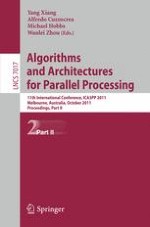This two volume set LNCS 7016 and LNCS 7017 constitutes the refereed proceedings of the 11th International Conference on Algorithms and Architectures for Parallel Processing, ICA3PP 2011, held in Melbourne, Australia, in October 2011. The second volume includes 37 papers from one symposium and three workshops held together with ICA3PP 2011 main conference. These are 16 papers from the 2011 International Symposium on Advances of Distributed Computing and Networking (ADCN 2011), 10 papers of the 4th IEEE International Workshop on Internet and Distributed Computing Systems (IDCS 2011), 7 papers belonging to the III International Workshop on Multicore and Multithreaded Architectures and Algorithms (M2A2 2011), as well as 4 papers of the 1st IEEE International Workshop on Parallel Architectures for Bioinformatics Systems (HardBio 2011).
